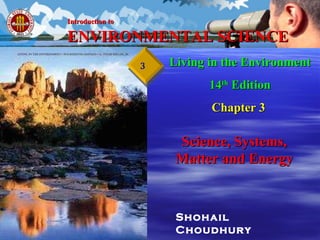
Science, System, Matter, Energy
- 1. Shohail Choudhury Living in the Environment 14 th Edition Chapter 3 Science, Systems, Matter and Energy Introduction to ENVIRONMENTAL SCIENCE 3
- 2. What is Science and What Do Scientists do? Science is an attempt to discover order in the natural world and use that to predict. Scientists collect data, form hypotheses, and develop theories, models and laws about how nature works. Fig: What scientists do? The Nature of Science Ask a question Do experiments and collect data Formulate hypothesis to explain data Do more Experiments to test hypothesis Revise hypothesis if necessary Well-tested and accepted hypotheses become scientific theories Interpret data Well-tested and accepted patterns In data become scientific laws Ask a question Do experiments and collect data Formulate hypothesis to explain data Do more Experiments to test hypothesis Revise hypothesis if necessary Well-tested and accepted hypotheses become scientific theories Interpret data Well-tested and accepted patterns In data become scientific laws
- 4. What types of matter do we find in nature? Matter is anything that has mass and takes up space. Matter has two forms: 1. Elements: building blocks of matter. 2. Compounds: 2 or more elements held together by chemical bonds. Chemists use symbols: e.g. Carbon (C), Oxygen (O), Calcium (Ca). Matter
- 5. Atom: The smallest unit of matter. Ion: An electrically charged atom/atoms Molecule: A combination of two or more atoms of the same or different elements. In nature we find molecules. For example nitrogen (N 2 ) and oxygen (O 2 ) are found in air. Here 2 is number of Atoms. Ex: O 3 is Ozone. Building Blocks of Matter
- 6. 1. Protons (positively charged) 2. Neutrons (uncharged) 3. Electron (negatively charged) Centre of the atom is Nucleus. Equal number of protons and electrons. So no net electrical charge. Each element has a specific atomic number. Atomic number is equal to number of protons in the nucleus. H=1, C=6, U=92 An atom is made up of a cloud of electrons that surrounds a nucleus containing protons and (in most cases) neutrons. Most of the mass of an atom is concentrated in the nucleus. So Atomic Mass= P+N in its nucleus. Inside Atom
- 7. Different isotopes of an element have different mass numbers. Isotopes: Elements with different Neutron numbers. Atomic Mass= P+N Examples of Isotopes
- 8. Atoms of some elements can lose or gain electrons to form ions. (See CD: Metals: Electron givers Non-metals: Electron receivers H + ions in a solution are a measure of how acidic or basic it is. The pH of a solution is a measure of its concentration of hydrogen ions (H + ). Neutral pH is 7; acid solutions are below 7; and basic solutions are above 7. Ions and P H
- 11. All compounds without the combination of carbon atoms and other elements’ atoms are inorganic compounds . Water, Carbon monoxide, Ammonia, Sulfuric Acid. Inorganic Compounds
- 12. Matter exists in four states: solid, liquid, and gaseous physical states and a fourth state known as plasma . 1.Water exists as ice, liquid, or water vapor depending on its temperature. 2.Plasma is a high-energy mixture of positively charged ions and negatively charged electrons. It is the most abundant form of matter in the universe, but very little is found on Earth. 3. Scientists make artificial plasmas in fluorescent light, arc lamps, neon signs, gas discharge lasers, and TV and computer screens. Four States of Matter
- 16. When matter has a physical change, its chemical composition is not changed; the molecules are organized in different patterns. In a chemical change, the chemical composition of the elements/compounds change. Shorthand chemical equations represent what happens in the reaction. The Law of Conservation of Matter states that no atoms are created/destroyed during a physical or chemical change. The same is true for energy. 1. Atoms are rearranged into different patterns/combinations. 2. Atoms can have physical or chemical changes, but they are never created nor destroyed. The Law of Conservation of Matter
- 17. Chemical equations are used to verify that no atoms are created or destroyed in a chemical reaction. The number of atoms on one side of the equation must equal the number of atoms on the other side of the equation. H 2 O H 2 + O 2 2H20 H 2 + O 2 2H 2 0 2H 2 + O 2 Chemical Equations
- 19. Energy efficiency/productivity measures the amount of useful work by a specific input of energy. Overall, energy efficiency is very poor—about 16% of energy produces useful work. 41% is unavoidable waste energy, and 43% is unnecessarily wasted energy. A change in habits can further reduce this waste . Energy Laws: Two Rules We Cannot Break The First Law of Thermodynamics states that energy can neither be created nor destroyed, but can be converted from one form to another. The Second Law of Thermodynamics states that when energy is changed from one form to another, there is always less usable energy. Energy quality is depleted. In changing forms of energy, there is a loss in energy quality; heat is often produced and lost. In living systems, solar energy is changed to chemical energy, then to mechanical energy. High quality energy degrades to low quality heat.
- 21. Next Class ECOSYSTEMS: How do they work Chapter 4 Quiz 1
Notes de l'éditeur
- Electromagnetic radiation: energy radiated in the form of a wave as a result of changing electric and magnetic fields. Cosmic, gamma, x rays are ionizing radiation it has the capacity to knock electrons from atoms and thus cause positive charges. This can disrupt living cells and lead to sickness or various forms of cancer.
